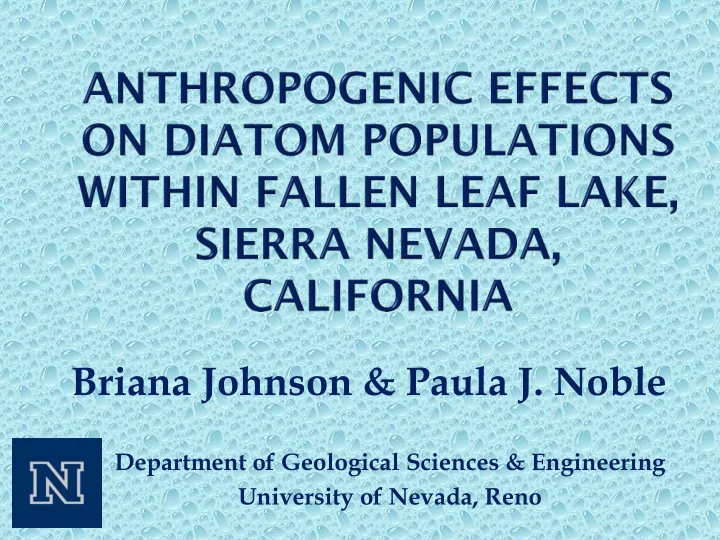

Briana Johnson & Paula J. Noble Department of Geological Sciences & Engineering University of Nevada, Reno
To use paleolimnological proxies to assess the impact of atmospheric nitrogen deposition, land use changes, and climatic variability on Fallen Leaf Lake over the past ~200 years
Diatoms are unicellular siliceous golden algae that live in any moist habitat Diatoms in sediment cores can be used to determine past lake level, water chemistry, & paleoecology They are sensitive to biological, chemical, & physical changes in water Eutrophication pH Salinity/Alkalinity
Anthropogenic Nitrogen Deposition • Beartooth Mountians (Wolf et al. 2001; 2003) • Colorado Front Range (Saros et al. 2003; 2005) Increasing A. formosa & Fragilaria crotonensis • Lake Tahoe Increasing F. crotonensis (Byron & Eloranta, 1984) Increasing shoreline algae and araphid pennate diatoms (Winder & Hunter, 2008) Asterionella formosa Climate Change & Nitrogen Deposition • Arctic Lakes Discostella spp. & Cyclotella spp. has replaced small benthic taxa (Hobbs et al., 2010)
• Near ultra-oligotrophic (Reuter et al., 1996) • Moderately impacted by homes and motorized activities • Gravity core from lake center taken in 2010 Modified from Kleppe et al., (2011)
Contour Plot of NO 3 0 m 10 m Metalimnion 20 m 30 m 40 m 50 m 6/01/09 7/27/09 6/26/09 8/28/09 9/25/09 09/02/2011 A. formosa comprises a large component of the phytoplankton and is also found in Gilmore Lake. Is this related to N-deposition?
Processed the top 10 cm of the ~40 cm sediment core Bolly FLL10 2E-1G-1 in 0.5 cm increments Completed 200 valve counts of diatoms for 10 samples in the top 10 cm of the core Identified diatom species present and any species composition changes Water quality data collected during run-off
Age Model for Bolly 2E-1G-1 Sediment Core Date A.D. 2050 2000 1950 1900 1850 1800 0 1 2 Base of Interval (cm) 3 4 5 6 7 8 9 10 Analyses run at Harmon Research Center by Dan Engstrom .
Sediment Accumulation Rate of Bolly 2E-1G-1 2010 2000 1990 1980 1955 -Dams for reservoir below Lily Lake 1970 Age of Base of Sample Interval 1960 washed away in storm 1950 1940 1938 -Glen Alpine Creek rerouted by 1930 storm near FLL 1920 1910 1908 -Anita Baldwin built 1 st dam at 1900 FLL outlet 1890 1880 1870 1861 -Nathan Gilmore brought cattle to 1860 FLL 1850 1840 1830 1820 1810 0 0.005 0.01 0.015 0.02 Sediment accumulation (g/cm² yr) Analyses run at Harmon Research Center by Dan Engstrom
The gravity core shows that A. formosa has been persistent since at least 1812 Aulacoseira subarctica has declined over the past 60 years in favor of F. tenera group Asterionella formosa Aulacoseria subarctica Fragilaria tenera group % of Total Valves % of Total Valves % of Total Valves 0.0% 20.0% 0.0% 20.0% 40.0% 0.0% 20.0% 40.0% 0% 10% 20% 0% 20% 40% 0% 20% 40% 2010-2008 2010-2008 2010-2008 2002-1997 2002-1997 2002-1997 1989-1981 1989-1981 1989-1981 1968-1952 1968-1952 1968-1952 1937-1931 1937-1931 1937-1931 1917-1902 1917-1902 1917-1902 1891-1880 1891-1880 1891-1880 1870-1860 1870-1860 1870-1860 1849-1839 1849-1839 1849-1839 1826-1812 1826-1812 1826-1812
Sample Date NH4-N NO3/NO2-N DP-P Sample Location Depth (m) Sampled (ppb) (ppb) (ppb) Secchi Depth (m) Gilmore Lake 0 8/7/2011 5 1 7 Gilmore Lake 10 8/7/2011 2 1 3 Gilmore Lake 20 8/7/2011 1 1 3 13 m (8/7/2011) & 11.5 m (10/15/2011) Gilmore Lake 30 8/7/2011 1 1 5 Gilmore Lake 40 8/7/2011 1 1 4 Gilmore Lake 50 8/7/2011 1 35 4 3.5 m (10/1/2011) Lily Lake 0 6/27/2011 3 21 3 Upper Angora Lake 0 6/27/2011 2 21 3 Upper Angora Lake 5 6/27/2011 2 22 3 6.5 m (6/27/2011) & 6.25 m (10/1/2011) Upper Angora Lake 8 6/27/2011 9 23 2 Upper Angora Lake 10 6/27/2011 24 24 3 Although FLL has higher NO 3 values during spring run-off, data from Gilmore Lake show NO3 may not be coming from the snowpack.
The sedimentation rate at FLL has increased since 1950 while F. tenera group has increased in and A. subarctica has decreased A. formosa is not a newcomer; chronic high abundance (5-10%) since 1812 Abundant in Gilmore Lake water column (10/15/2011) The data does not support anthropogenic N- deposition as a factor in the recent diatom community composition
Fallen Leaf Lake Sediment & Geochemical Analyses Sediment Core Bolly 2E-1G-1 Carbon & Nitrogen Concentration & Isotopes Phosphorous Concentration Diatom Analysis & Ecologic Interpretation Gilmore Lake (Low Impact) Sediment core - summer 2012
What other factors may account for chronic A. formosa in FLL & Gilmore Lake? Land use changes Climate Fish manipulations Are any of the changes seen in FLL also seen in other similar lakes inside and outside of the Tahoe basin?
LacCore Bob Karlin - UNR Laurel Stratton - UNR Jason Barnes – UNR U.S. Fish & Wildlife Service U.S. Forest Service Sudeep Chandra - UNR Kerry Howard - UNR John Kleppe – UNR Alan Heyvaert - DRI
Recommend
More recommend